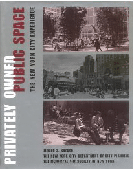
767 Fifth Avenue
The plaza in front of the former General Motors Building on the east side of Fifth Avenue between East 58th and 59th Streets is undergoing a radical identity change. To begin with, it will henceforth be known as the Trump International Plaza at the General Motors Building. Furthermore, it will virtually eliminate the conspicuously sunken plaza at its heart. Finally, it will be famous, seen on a daily basis by more people than see all the other privately owned public spaces in the city combined.
The design embraced by new owner Donald Trump and partners fills in the majority of sunken plaza with below-street-level retail tenants and covers them with street-level plaza. It will be hard to find many who will lament the loss. In an urban environment favoring street activity and easy access, sunken and elevated plazas have struggled to find their place. Declining to complement the Grand Army Plaza across Fifth Avenue with another street-level confection, the original architect Edward Durell Stone chose instead to unhinge entirely from the street. That strategy could be deemed courageous or cowardly. Certainly the street-level competition was daunting. The Grand Army Plaza is a vibrant example of beaux-arts urban design and civic philanthropy. An initial concept by sculptor Karl Bitter, an implementing design by Thomas Hastings, and Joseph Pulitzer’s lubricating $50,000 contribution in 1912 for the construction of a centerpiece marble fountain topped by Bitter’s bronze sculpture of the Greek goddess Pomona, laid the foundation. To the north is Augustus Saint-Gaudens’ statue of General William Tecumseh Sherman astride his horse. The French Renaissance façade of the Plaza Hotel brilliantly encloses the space to the west, and Central Park beckons further north. As a piece of urban design, the plaza to this day masterfully accommodates the unruly movements of pedestrians, taxis, horse-drawn carriages, limousines, and private cars that venture on and across its surface.
In contrast, the old General Motors plaza created a large, dark cavity in the ground plane. Carpeted with astroturf and crammed with umbrella-topped tables and chairs, it was used by a full-service restaurant and bar during the warmer months of the year and left empty at other times. With its elimination, the questions that arose about whether the restaurant was legally authorized to operate in the public space become moot. The city is now left with three substantial outdoor sunken public spaces, at the McGraw-Hill, Paramount Plaza, and Citigroup Center buildings.
The new design still plays, ever so slightly, with grade changes. The space itself will now be elevated several steps above the public sidewalk. It retains a small reminder of the sunken space between East 58th and 59th Streets close to Fifth Avenue, with a stairwell leading down to a small landing in front of a 37-foot-wide glass entrance to the below-grade retail. An above-grade green marble roof covers the retail entrance, and an above-grade platform surrounded by steps on three sides is located still further east. Two narrow, 65-foot-long rectangular pools with water jets and encircling sittable ledges make apparent reference to the Seagram plaza on Park Avenue. The existing terraces at north and south ends will remain, slightly higher than the rest of the space, decorated with rows of trees and marble benches.
The most famous geography of the plaza will be north of the building’s arcade, where new tenant CBS has established a studio for its relaunched morning talk show. Windows and cameras look directly onto the plaza and on-air personnel venture outside to greet onlookers, allowing millions of morning television viewers across the country to become familiar with the space. How this works will have to be followed carefully so that this part of the plaza maintains its status as a “public” space. More plaza space that is functionally extra sidewalk will remain on Madison Avenue. When this project is complete, developer Trump will have renovated privately owned public spaces at two of Central Park’s four corners. His other Central Park public space is located at the Trump International Hotel and Tower, at the southwest corner of Central Park.




I am using Google street view to create immersive 360degree views of POPS. You use googlCheck Out 599 Lexington Ave
Shared via the #StreetView app
https://www.google.com/maps/@40.7639138,-73.9730459,3a,75y,80h,70t/data=!3m4!1e1!3m2!1sAF1QipNJY2SL3AQKIrGvKsTA9IWWDuCiCN2_w4oSnWaM!2e10